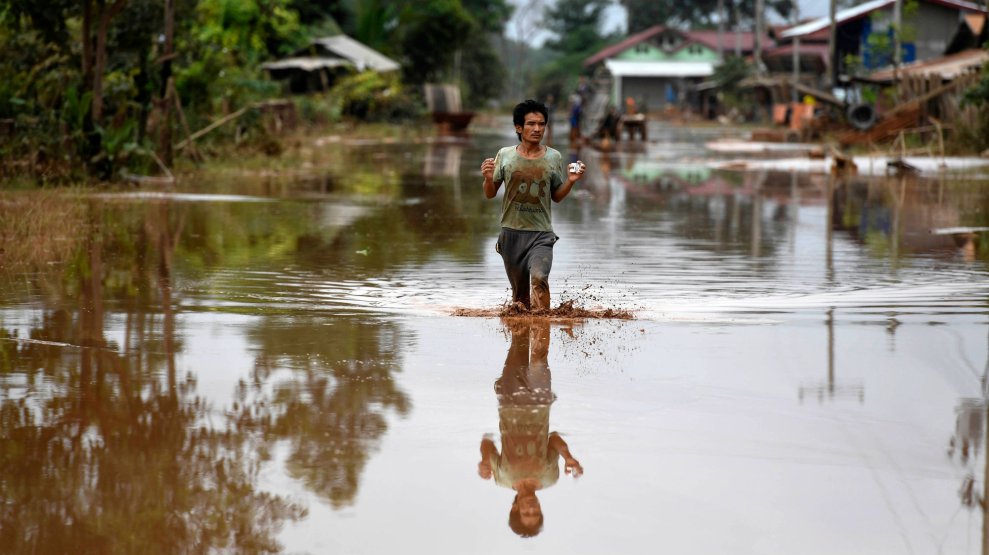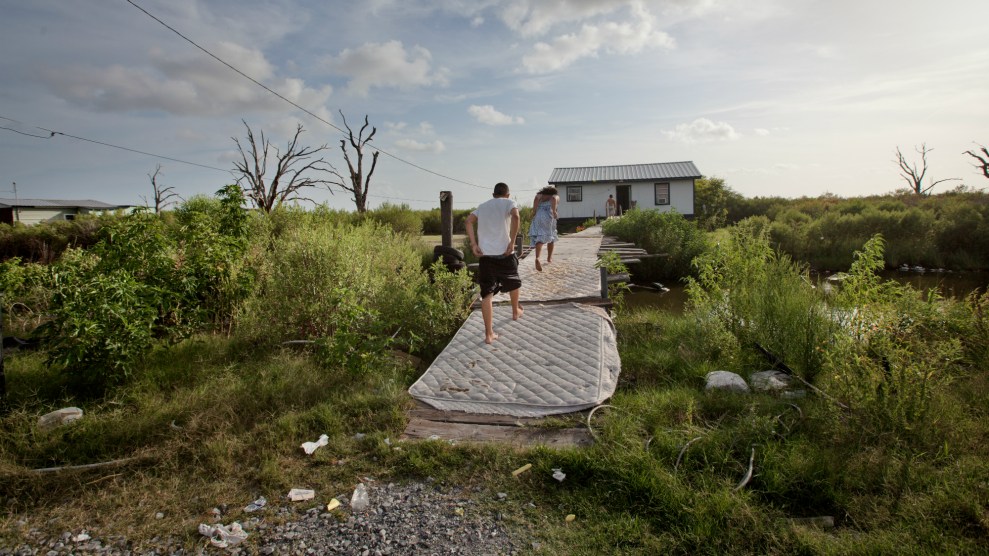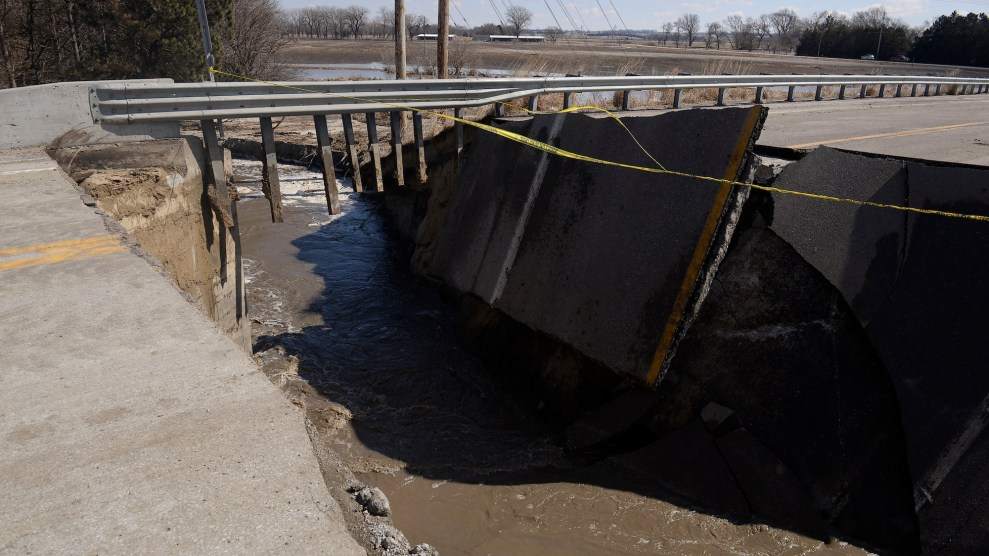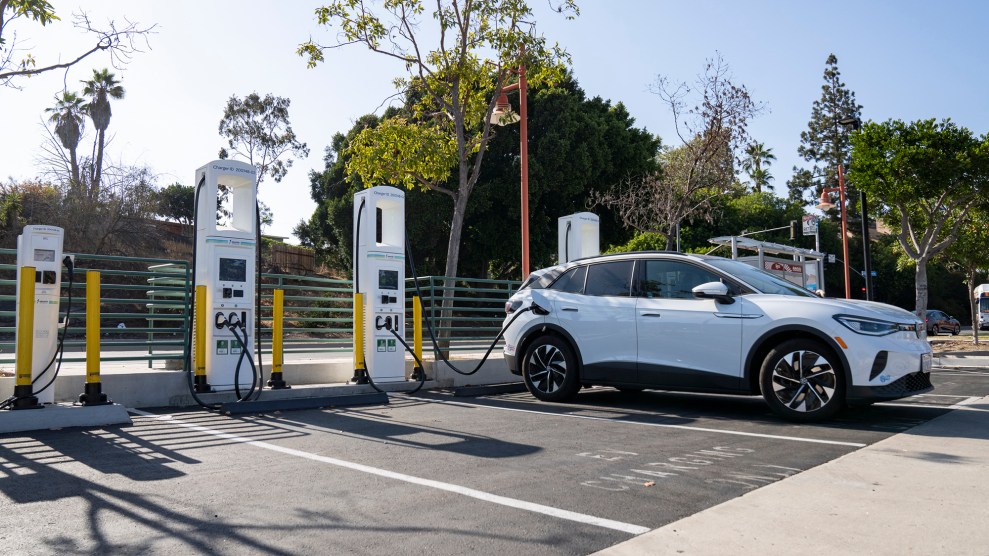
More than 6,000 people were left homeless after a dam under construction in Laos crumbled in July 2018, flooding towns downstream.Nhac Nguyen/AFP/Getty
This story was originally published by Yale Environment 360 and appears here as part of the Climate Desk collaboration.
It is a telling illustration of the precarious state of United States dams that the near-collapse in February 2017 of Oroville Dam, the nation’s tallest, occurred in California, considered one of the nation’s leading states in dam safety management.
The Oroville incident forced the evacuation of nearly 190,000 people and cost the state $1.1 billion in repairs. It took its place as a seminal event in the history of US dam safety, ranking just below the failures in the 1970s of two dams—Teton Dam in Idaho and Kelly Barnes in Georgia—that killed 14 and 39 people, respectively, and ushered in the modern dam safety era.
The incident at the half-century-old, 770-foot-high Oroville Dam, which involved partial disintegration of its two spillways during a heavy but not unprecedented rainstorm, signaled the inadequacy of methods customarily used throughout the country to assess dam safety and carry out repairs. It occurred as federal dam safety officials have made substantial progress in updating methods of dam assessment, in the process propelling dam safety practices into the 21st century. But federal and state dam safety officials have been unable to procure from disinterested state legislatures and Congress the tens of billions of dollars needed for repairs to the nation’s aging dam infrastructure.
Largely as a result of the funding shortfall, in its latest infrastructure report card, in 2017, the American Society of Civil Engineers (ASCE) gave the nation’s 91,000-plus dams a D grade, the same grade they have received in every ASCE report card since the first one was issued in 1998. The ASCE estimated the cost of rehabilitating dams whose failure would threaten human life at nearly $45 billion, and the cost of fixing all dams in need of repair at more than $64 billion. This year, the Association of State Dam Safety Officials (ASDSO) arrived at an even higher number — nearly $71 billion for all dams.
“There’s a huge backlog of rehabilitation needs regarding dams in our country,” said Lori Spragens, ASDSO’s executive director. “Regular citizens are unaware that the dams around them may be risks, and there’s not enough public awareness for people to be prepared, just like they would be for a tornado or an earthquake.”
And scientists say the likelihood of dam failures—which not only threaten lives but also release toxic sediments trapped in reservoirs behind many dams—will increase as extreme precipitation events become more frequent in a warming world.
Aside from about 1,500 dams owned by federal agencies, regulating dam safety is chiefly a state responsibility, and states vary widely in their commitment to the task. Across the nation, each state dam inspector is responsible on average for about 200 dams, a daunting ratio, but in some states the number is much higher. Oklahoma, for example, employs just three full-time inspectors for its 4,621 dams; Iowa has three inspectors for its 3,911 dams. Largely because of its legislators’ distrust of regulation, Alabama doesn’t even have a safety program for its 2,273 dams.
States require inspections of “high-hazard-potential” dams, whose failures would cause fatalities, every two-and-a-half years on average, but actual inspection intervals are much longer. Eleven states don’t inspect “low-hazard-potential” dams—dams that don’t threaten lives or property—at all.
Among states given high marks for their programs are Pennsylvania, New Jersey, Colorado, Washington, New Mexico, and, at the top of most lists, California, which spends the most of any state on dam safety, more than $21 million in 2017. Yet an independent report on the causes of the Oroville incident published in January 2018 faulted California’s dam safety practices in numerous ways.
While the dam was inspected regularly, safety officials failed to look more deeply into the dam’s history, and consequently missed deficiencies in its main spillway that stemmed from its design and construction. California’s Department of Water Resources was “overconfident and complacent about the integrity” of its dams, and was “chronically” understaffed, the report said. And the department lacked expertise in dams’ secondary structures, such as the failing spillways.
“The fact that this incident happened to the owner of the tallest dam in the United States, under regulation of a federal agency, with repeated evaluation by reputable outside consultants, in a state with a leading dam safety regulatory program, is a wake-up call for everyone involved in dam safety,” the report said. “Challenging current assumptions on what constitutes ‘best practice’ in our industry is overdue.”
Until the 1970s, information about the nation’s dams was scant: some hadn’t been inspected for decades, and nobody knew how many existed. After numerous dam disasters, the nation’s first dam inventory in the early 1970s established the existence of nearly 90,000 non-federal dams, most of them small. Inspections of about 9,000 of them found that a third were unsafe. Since the federal government had no responsibility for those dams, the states then began to take their dam safety responsibilities seriously.
Dam safety programs are generally considered to have improved since then, but dam failures—the rapid, uncontrolled release of water when dams are breached or collapse—are still frequent. According to the ASDSO, between January 2005 and June 2013, state dam safety programs reported 173 dam failures and 587 “incidents”—events that probably would have resulted in failures if not for quick interventions. Fatalities caused by dam failures are far less common. Since the collapse of the Kaloko Dam in Hawaii in 2006, which killed seven people, no deaths occurred until this March, when Nebraska’s Spencer Dam, just 29 feet high, gave way to epic floodwater, sweeping away a house with a man inside it in the floodplain below.
One sure way to eliminate a dam’s danger is to dismantle it, but the impact on safety of the budding US dam removal movement has been minimal. One reason is that most of the removed dams were small, less than 25 feet high; another is that relatively few dams have been removed. Last year marked a high point, with 99 dams taken down. But that number represents only about a thousandth of the nation’s dam stock.
Conservation groups and anglers’ organizations such as Trout Unlimited have led the drive to take down US dams, often to help restore long-blocked fish migrations. These groups note that removing a small dam may cost less than repairing it. But removing a large dam can cost as much as building it in the first place. Efforts to dismantle large dams on major rivers, such as the Snake River in the Pacific Northwest, have faced strong resistance from business groups and utilities, which defend the dams for generating hydropower and creating reservoirs used to ship grain and other commodities.
As sobering as the problem of dam safety is in the United States, consider that aside from Australia, Canada, and Western Europe, dam safety standards in the rest of the world lag behind the US Catastrophic failures are frequent: Since August 2008, when a dam in Nepal gave way, killing 250 people, at least 10 dam failures have each killed 10 or more people. In January, a mining dam in southeastern Brazil collapsed, killing about 300 people. Last year, a dam under construction in Laos crumbled, killing 40 people and leaving 6,600 homeless, and a dam in Kenya burst, killing 48 people.
In the US, three interlocking developments have impeded improvements in dam safety in recent decades. First, the nation’s dams are growing old: their average age is 57. By that age, seepage can start to erode dams’ foundations—the US Army Corps of Engineers spends about $200 million a year to address seepage on its dams alone. And parts such as spillway gate, motors, winches, and generators wear out and need replacement.
Second, dams are vulnerable to so-called “hazard creep”: their danger increases as development occurs downstream. A dam that was rated “low-hazard-potential” when it was built because nobody lived in the floodplain below may become a “high-hazard-potential” dam once people move into the area. As a result, even though new dam construction in the US virtually stopped in the 1970s, the number of high-hazard-potential dams has grown from 9,314 in 1999 to 12,557 in 2017. High-hazard-potential dams must conform to a more rigorous safety standard than lesser-rated dams, but if funds aren’t available, the necessary upgrades won’t be made. And dam safety officials are often slow to reclassify dams. Neither Kaloko nor Spencer dams, for example, were rated high-hazard before their fatal collapses.
Hazard classifications have other problems, too. Owners of high-hazard-potential dams are supposed to maintain emergency action plans to notify downstream residents of imminent danger from a dam, but according to Mark Ogden, an ASDSO outreach specialist, nearly 20 percent of high-hazard-potential dams lack such plans.
And while hazard classifications take into account threats to human life, they don’t consider the environmental and economic damage that could be caused by the release of toxic sediments. That sediment may include agricultural pesticides, mining tailings, and industrial chemicals.
Despite the potential dangers posed by dams, many people living on property that would be flooded if a dam fails are unaware of that possibility, in part because federal officials blocked public access to inundation maps after the September 11, 2001 terrorist attacks. In recent years, some states have again made the maps available. California requires that prospective buyers be informed if a property is in an inundation zone, a practice that should be far more widespread.
The third development affecting dam safety is a deepening understanding of hydrological conditions and earthquakes, both of which are vital considerations in dam design. Assumptions about floods and precipitation when dams were built were typically based on a short history of hydrological data, and another half-century or more of information often has pointed to different conclusions. Climate change, which is intensifying both floods and drought, has further undermined those assumptions.
The result is that the methods dam designers and safety officials have customarily used are increasingly considered inadequate. Dam design traditionally has been based on calculations of its watershed’s “probable maximum flood,” or PMF, the largest flood that could conceivably occur there. High-hazard-potential dams were supposed to be able to safely handle PMFs; low-hazard dams usually were required to contain some fraction of their PMFs. And if accumulating hydrological data showed that a dam’s original PMF was too low, the dam could be labeled out of compliance and required to undergo repairs, often by enlarging its spillway. Indeed, about half the investment in dam repairs throughout the US involves modifying spillways to accommodate larger floods, according to Eric Halpin, who retired in January after 14 years as chief of dam and levee safety at the Army Corps of Engineers.
But focusing solely on PMFs entirely omits the varying levels of risks that dams may pose. One PMF may be calculated to have a one-in-a-thousand chance of occurring in a given year, while another might be pegged at one-in-a-million. And a few people might live in the floodplain below one dam, while a million might live downstream from another. As a result, the Bureau of Reclamation abandoned its focus on PMFs in favor of risk-based assessments about 25 years ago, and the Army Corps of Engineers followed a decade later. Now risk assessment is making its way into the procedures of some state dam safety agencies.
Incorporation of climate change into dam safety practices is still limited by scientists’ inability so far to quantify the frequency and intensity of future flooding in particular localities. One small step in that direction has been taken at California’s Folsom Dam, which recently became the first dam to use National Weather Service forecasts about future precipitation to help guide decisions about whether to release water from the dam’s reservoir. Until now, release decisions were based entirely on readings of precipitation that had already occurred.
Even with smart measures like these, major advances in dam safety almost certainly won’t occur until legislatures begin appropriating many billions of dollars more for repairs. Instead, since a majority of dams are privately owned, about half the states have shifted to owner-responsible inspection systems, in which dam owners are required to hire inspectors and pay for the inspections themselves instead of relying on state inspectors.
“In my last 15 years in government,” Halpin said, the Army Corps of Engineers “invested half-a-billion to a billion dollars a year in infrastructure repairs. During that same period, Congress appropriated $200 billion for emergency funds to repair infrastructure damage from storms” such as Katrina and Sandy. “Everyone knows it’s more cost-effective to prevent damage than to repair it, but it’s not in the national will yet. This is not politically sexy.”
















